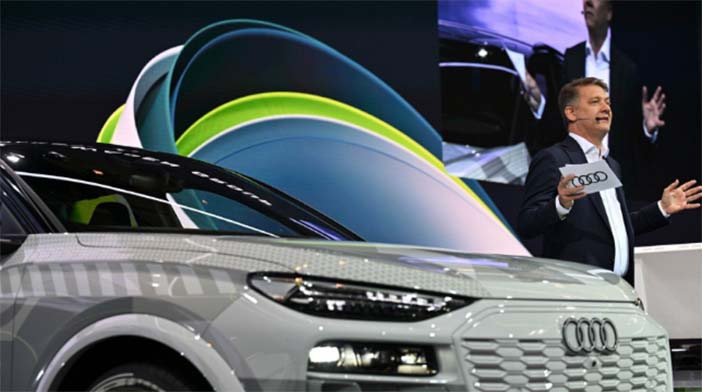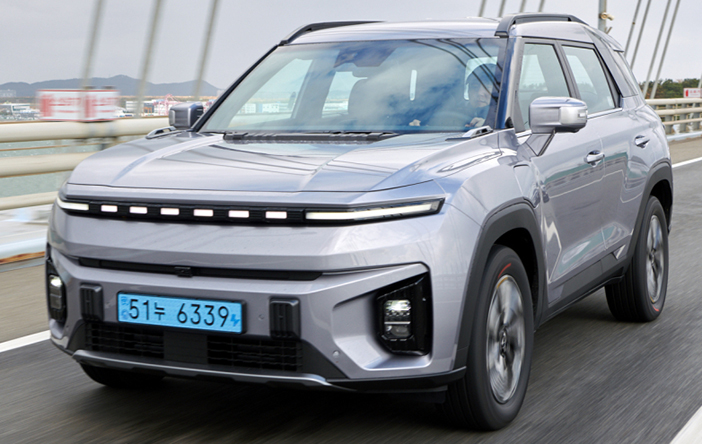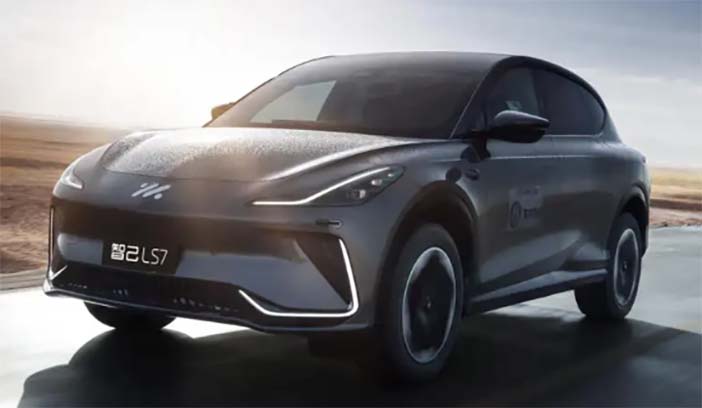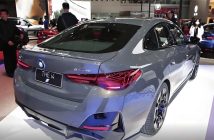+++ AUDI chairman Gernot Döllner (photo) is expected to table a motion calling for the firm’s technical development boss, Oliver Hoffmann, to step down with immediate effect when its board meets, sources have revealed. The move, described as one of many high-level management and operational changes Döllner plans to present to its members, comes after delays in the introduction of several key Audi production models. Hoffmann, appointed board member responsible for technical development at Audi in 2021, has come under fire from Döllner in recent months. The new Audi chairman openly held the 46-year-old engineer responsible for the drawn-out development process and subsequent delay of the electric-powered Q6 e-Tron (photo), a sibling to the recently unveiled Porsche Macan, as well as the replacement model for the existing fifth-generation Audi A4, which will be renamed the Audi A5. +++

+++ Hyundai Glovis, the logistics unit of South Korea’s largest automaker, the Hyundai Motor Group, joined forces with Korea Ocean Business Corporation (KOBC) to add 4 more large-scale CAR CARRIERS , or PCTCs, which can carry 10.800 small vehicles. PCTCs, short for Pure Car and Truck Carriers, are LNG-fueled vessels used for transporting vehicles. The PCTCs Hyundai Glovis plans to deploy are the world’s largest car carriers in terms of capacity, as the current capacity of the largest car carriers ranges from 7.000 to 7.500 units. Hyundai Glovis announced earlier this month that it has signed a deal with state-owned KOBC to commission the construction of the largest car carriers as part of its plans to secure 28 LNG-powered PCTCs in its fleet by 2027. This partnership aims to address the logistical challenges in automobile exports, exacerbated by a shortage of car carriers. KOBC will cover construction costs, and Hyundai Glovis will take on the leasing and operation of vessels upon its completion in 2027. The global container shipping sector is facing a rare shortage of car carriers, leading to a surge in freight rates, according to South Korea’s shipping industry. Historically, the car carrier segment has operated distinctly from other maritime transportation, such as container ships and bulk carriers. Carmakers were limited to a few regions (North America, Europe, Japan and South Korea) and most vehicles were sold domestically. While PCTC construction was centered in North America and Europe, the leading carrier operators were predominantly in South Korea and Japan. These operators transported vehicles produced in Soutn Korea and Japan to North America and Europe, and vice versa. But this relatively niche market is facing changes as China ramped up electric vehicle (EV) production in the past few years. EV shipments from China jumped from 600.000 units in 2020 to 3 million units last year. A surge in export volumes had led to a shortage of PCTCs. Car carrier freight rates, which were around $16.271 for a 6.500 CEU (Car Equivalent Unit) vessel in 2020, surged to $115.000 in January this year. A sharp increase in demand coupled with tight supply has been pushing up freight rates. On the supply side, 49 car carriers that failed to meet the International Maritime Organization’s energy efficiency and carbon emission standards have been dismantled. Between 2016 and 2020, orders for car carriers declined as leading carmakers built production factories closer to their markets. But China’s EV production boom in recent years boosted demand for car carriers. BYD sold 526.000 EVs in the global market in the 4th quarter of last year, surpassing Tesla for the first time. Global demand for EVs has slowed this year, but Chinese carmakers continue to clear out inventory by lowering prices. Exports of cars made in Korea and Japan are also on the rise. Hyundai and Kia topped 2 million units in exports last year for the first time in 7 years. Car shipments from the Far East (China, Japan and South Korea) which accounted for 42% of global car shipments in 2020, rose 51% last year. Facing challenges in securing car carriers, Chinese carmakers are constructing and managing their own carrier fleets and extending long-term charter agreements. BYD dispatched its first car carrier from Shenzhen Port, China, to Europe this January. This vessel transported 5.449 EVs. Korea’s leading shipping companies are also adapting to these changes. HMM rebooted its automobile transportation business, ordering 7 new car carriers and signing a 15-year charter contract worth 2 trillion won. The vessels are expected to be delivered in 2026. Hyundai Glovis will expand its fleet of 83 ships to 110 by 2027. +++

+++ The HYUNDAI MOTOR GROUP will invest $1.1 billion in Brazil by 2023, focusing on the advancement of eco-friendly future mobility and relevant technological development, the automaker said Friday. As part of its initiative, the automaker committed to align with Brazil’s carbon neutrality policy. Hyundai intends to develop eco-friendly vehicles tailored specifically for the local market and establish a dedicated division for its hydrogen business in the region. Hyundai Motor Group executive chairman Chung Euisun convened with Brazilian President Luiz Inacio Lula da Silva on Thursday to explore avenues for enhancing their collaboration. Jose Munoz, the global chief operating officer for Hyundai, participated in the meeting alongside the country’s leader and other prominent politicians. Brazil is a pivotal sales region for Hyundai, propelled by the demographic growth potential within the area. The automaker reported sales of over 187.800 vehicles there in 2022 alone, which represents nearly 10 percent of the country’s automotive market share. “The Hyundai Motor Group is pushing ahead with rapid electrification strategies to achieve net-zero emissions, with the focus on electric and hydrogen vehicles”, Chung said. “Hydrogen energy is the key means to deal with climate change and supplement our electrification”. Hyundai Motor’s subsidiary in Brazil and local partners there will team up for the mega-investment project. “The Hyundai Motor is expanding its presence in Brazil and the company will invest in the eco-friendly hydrogen and relevant technological development in Brazil”, the Brazilian president said. The Brazilian government has committed to a substantial reduction in greenhouse gas emissions, aiming for a 50 percent decrease by 2030 compared to levels from 25 years prior. Furthermore, it has outlined an ambitious long-term goal of achieving carbon neutrality by 2050. Last year, the country announced plans to offer tax cuts and subsidiaries worth 5.1 trillion won for global automakers investing in Brazil’s decarbonization. Chung also explained the automaker’s vision for advanced air mobility (AAM) during the meeting, as part of its efforts to preemptively secure technological competitiveness for the future mobility solution. Last month, the automaker’s AAM subsidiary unveiled a concept of its latest S-A2 all-electric passenger aircraft whose commercial debut is slated for 2028 in South Korea and the United States. The head of the Hyundai Motor Group also met with a group of ranking officials from Brazilian universities and exchanged their views on how to elevate ties between Hyundai and researchers there. “The Hyundai Motor Group will help relieve energy inequality with its hydrogen business, and hopes to lead Brazil’s eco-friendly energy market under our close collaboration with the Universidade de Sao Paulo”, Chung said. +++
+++ JAPAN ’s carmakers are keeping their foot on the accelerator when it comes to investing in electric vehicles. Yes, EV sales growth is slowing, executives have said this earnings season. But this hasn’t come as a shock to manufacturers that largely have been content to let the rest of the world race to electrify before batteries are cheap and enough charging infrastructure is built. In other words, Japan’s auto companies knew car buyers weren’t ready just yet to go electric as quickly as some hoped. “The customer decides the speed of electrification”, Stephen Ma, Nissan’s chief financial officer, said this month. “Electrification is not linear growth, a straight line. It will go up and down. But long term, it will grow”. Carmakers including Tesla have been resetting expectations as the pace of EV expansion slows. Many consumers hit by high inflation and interest rates still find electric cars to be out of reach, and several automakers have yet to roll out products that appeal beyond luxury buyers or early adopters. These factors have helped fuel record hybrid sales for Toyota. A weaker yen also is boosting profits across Japan’s auto sector, giving companies room to bide their time to build capacity and develop EVs at a more deliberate pace. “There is always the danger that a hybrid becomes so attractive to an incumbent like Toyota, that they get trapped in it as well, and therefore are too slow in responding to the disruption” said Nathan Furr, a professor of strategy at the Insead business school in France. “There was a time when I worried this would be the case for Toyota. But now we are seeing a slowdown in the adoption and enthusiasm for EVs among consumers, so perhaps it is a wise strategy”. Honda CFO Eiji Fujimura said this month the company knew a slowdown in EVs could happen. Even so, he said “electrification must go forward” to achieve carbon neutrality, and the carmaker will keep pushing forward with its EV strategy. Subaru executive vice president Tomoaki Emori said the company factored in the possibility that the EV market will reach a growth plateau when formulating its ¥1.5 trillion ($10 billion) investment plan for electrification. Nissan, for its part, committed ¥2 trillion in 2021 to accelerate electrification over a 5-year timespan. Ma said the company will make necessary investments to offer the right products to its customers. No other Japanese carmaker has drawn as much criticism from environmental groups and some investors for its deliberative approach as Toyota, which has said that hybrids, alternative fuels including hydrogen and other technologies are needed in addition to battery EVs. Toyota CFO Yoichi Miyazaki said hybrids that don’t require charging infrastructure are drawing consumer support as “a realistic solution”. The world’s No. 1 carmaker is now preparing to sell 5 million gas-electric vehicles annually as soon as 2025, a year earlier than previously expected. Toyota, Honda and Panasonic (which supplies car batteries to Tesla and Toyota) were the only Japanese businesses in the top 20 companies pledging foreign direct investment in EV-related activities between 2016 and 2022. Outside of Japan, signs of a scaling back are everywhere, with the exception of China. Ford is reducing the number of workers making its F-150 Lightning, while General Motors has delayed plans to expand its electric pickup production. Renault scrapped plans to list its electric-vehicle business and Volkswagen has put off efforts to seek outside investors for its battery unit. Tesla warned that its rate of expansion will be “notably lower” this year, and staff are bracing for potential job cuts. The EV manufacturer’s shares have declined about 20% this year. Despite the continued success of hybrids, Toyota’s Miyazaki said the company doesn’t believe they’re all that’s needed. Toyota will continue to pursue a full lineup that includes battery-electric, plug-in hybrid and hydrogen powertrains to “be ready to respond to any demand that comes our way”, he said. +++
+++ KG MOBILITY has achieved a major turnaround in 2023 with a surprising triple-digit operating profit for the first time since 2016, buoyed by robust sales of its diverse SUV lineups (such as the Torres and Rexton), the company said Wednesday. According to the automaker, the firm attained record annual sales of 3.74 trillion won ($2.8 billion) last year, up 9.3 percent from the previous year. Its operating profit also soared to 12.55 billion won during the same period on its improved product mix and enhanced brand image after formerly SsangYong Motor changed its corporate name to KG Mobility in March 2023, the company said. The once-cash-strapped Korean automaker raised hopes for its stronger earnings recovery this year by continuously improving its SUV-focused product mix. The company reiterated its plans to place a more strategic focus on increasing sales for its pure-electric mid-sized SUV, the Torres EVX (photo), this year. “Placing Torres EVX at the forefront of our major sales lineup, we are going to diversify our lineup by launching a coupe version of the Torres in the third quarter of this year, and the Torres electric pickup truck in the fourth quarter”, a spokesman for the automaker said. KG Mobility recently decided to cut the price for Torres EVX by 2 million won, after a government subsidy for the vehicle fell to 4.57 million won this year from 6.6 million won a year ago. The automaker said that the firm pushed for the temporary discount for the model to alleviate the lingering financial burden on customers for electric vehicles (EV). But the promotional event will only last until the end of this year. “Our overall profitability for each vehicle sale improved on falling material costs”, the official said. “KG Mobility will continue to enhance its profitability by diversifying its competitive SUV lineup for customers”. +++

+++ In a strategic move, the SAIC co-owned IM brand is set to rebrand its models, including LS6, LS7, L6 and L7, as MG for sales in the European and South American markets. This transition aims to capitalize on MG’s global success and boost sales in overseas regions. Both MG and IM fall under the umbrella of SAIC, one of China’s leading automotive manufacturers. IM Motors is the collaboration of SAIC Motor Corporation Group, Zhangjiang High-Tech Park, and Alibaba Group which is aimed at rivaling the likes of Tesla and Nio. SAIC is responsible for the production of the IM-branded vehicles. MG, established in 1924 in Oxford, holds a rich century-long history and is now owned by SAIC Motor Corporation. IM’s models are mid-sized vehicles with more luxury can also fill a gap in MG’s current line-up. IM’s line-up: IM L7 is the brand’s first model. It is a large sedan with dimensions of 5.098/1.960/1.485 mm and a wheelbase of 3.100 mm. Its top trim level has 4WD for 445 kW and a 90 kWh ternary NMC battery. The IM LS6 is a mid-size fastback SUV with dimensions of 4.904/1.988/1.669 mm and a wheelbase of 2.950 mm. The top trim has 4WD for 396 kW and a 90 kWh ternary NMC. IM LS7 (photo) is a larger SUV than the LS6 with dimensions of 5.049/2.002/1.773 mm and a wheelbase of 3.060 mm. It has 4WD for 425 kW and a 100 kWh ternary NMC. IM L6 is the brand’s latest model that has yet to enter the Chinese market. Its dimensions are 4.931/1.960/1.474 mm with a wheelbase of 2.950 mm. Its performance variant has up to 800 hp. There are 2 battery options for the L6: 90 kWh and 100 kWh for 700-770 km range. Currently, IM vehicles are exclusively available in mainland China, the cumulative sales for 2023 reached 38.253 units. However, it lags significantly behind its primary competitors. In contrast, Tesla achieved sales exceeding 645.000 units in China throughout 2023, Xpeng delivered over 121.000 cars and Nio successfully sold more than 160.000 EVs. The planned rebranding effort aims to strengthen IM model sales in Europe and South America. MG’s global sales exceeded 840.000 units in 2023, marking its fifth consecutive year as the top Chinese automotive brand in terms of export volume, contributing to around 70% of SAIC Group’s overseas sales. MG’s success extended to 16 developed countries, including Western Europe and Australia, where sales reached nearly 380.000 units. Models like the MG 4, MG ZS and MG 5 consistently secured positions in the top ten of export lists. The MG 4 specifically became the best-selling compact electric vehicle in Europe, surpassing 130.000 units in overseas sales, with monthly sales exceeding 10.000 units. Recent years have seen various models from SAIC Roewe and SAIC-GM Wuling successfully exported by rebranding them as MG. The Roewe Ei5, was rebranded as MG5. The Wuling Air EV transformed into the MG Comet and MG Hector, achieving commendable sales in the Indian market. The upcoming year, 2024, holds special significance as it marks the 100th anniversary of the MG brand. SAIC Group has set ambitious goals, targeting a global annual sales target of 1.35 million units in 2024. With MG’s brand serving as a driving force, SAIC achieved overseas sales of 1.208 million units in 2023, reflecting an 18.8% year-on-year increase. This accomplishment secured SAIC’s position as the top Chinese automaker for eight consecutive years enabling China to surpass Japan and become the world’s leading exporter. +++

+++ Hyundai, Tesla and KG Mobility are rushing to cut the prices of their flagship electric vehicles (EV), in a move to spur their sluggish sales amid freezing market sentiment in SOUTH KOREA . The automakers have had no choice but to reduce their margins by reducing their prices, as demand for EVs shows clear signs of abating this year due to their still relatively high prices. Customers are now seeking alternatives, such as hybrid cars that come with a decent range and cheaper prices than most EVs. Tesla decided to reduce the price of the Model Y by 2 million won ($1.502), as customers face more of a financial burden, with the Korean government deciding to offer a reduced subsidy this year for the best-selling imported EV here. Other automakers have also jumped on the bandwagon, in a move to rev up sluggish EV sales and maintain price competitiveness. KG Mobility also slashed the price for its Torres EVX by 2 million won, as the company also fell victim to the environment ministry’s recent decision to cut the subsidy for the firm’s strategic EV. Hyundai also cut the price for its flagship EVs, such as the Ioniq 5 and Ioniq 6 by 2 million won, respectively. The automaker also decided to offer a discount of 800.000 won for its Kona Electric. Kia, another subsidiary of the Hyundai Motor Group, launched a more aggressive promotional campaign for its so-called EV Festa. The automaker will provide a discount of 3 million won for its EV6. Kia will also reduce the price of its most expensive electric vehicle, the EV9 by 3.5 million won. Industry officials said automakers will continue to launch more aggressive promotional campaigns, as demand for EVs is not displaying signs of rebound anytime soon. “The interest rates remain at a burdensome level for most customers, so less are choosing to buy EVs, but other price-competitive yet economic vehicles such as hybrid cars”, an official from an automaker said. “Prices will be the biggest selling point for EVs this year, as the economy is widely forecast to remain in the doldrums”. +++
+++ STELLANTIS boss Carlos Tavares has his attention fixed on Chinese competitors as the automaker amps up the launch of its electric vehicle strategy. Stellantis will launch 18 new electric vehicles this year, 8 of those in North America, increasing its global EV offerings by 60%. But Tavares told reporters that “the job is not done” until prices on electric vehicles come down to the level of combustion engines, something that Chinese manufacturers are already able to achieve through lower labor costs. “The Chinese offensive is possibly the biggest risk that companies like Tesla and ourselves are facing right now’’, Tavares told reporters. “We have to work very, very hard to make sure that we bring out consumers better offerings than the Chinese”. He compared the Chinese offensive in the United States to the arrival of Japanese competitors in the 1970s and Korean carmakers in the 1990s, taking a significant market share. “So do we want that the Chinese carmakers take a significant share of the U.S. market in the next 20 years, or the next 10 years? I don’t know. That is the question. So how do we prevent that from happening beyond all the protectionist decisions, which are out of my reach? Well, by making our consumers happy”. In Europe, Stellantis is taking orders on the new Citroen ë-C3, aimed at the middle class and selling for 24.,290 euros in the Netherlands with a range of 320 kilometers and will soon offer a 200-kilometer range entry model at 20.990 euros from 2025, both being sold at a profit. Beyond price, he said consumers need to see a “dense charging network” to buy into the technology. Tavares suggested that government incentives offering subsidies to purchasers are the best way to get consumers to buy electric vehicles, saying in countries which offer such plans, EV sales are boosted by 20.000 additional units. He repeated that incentives might be a way out of a tiff with the Italian government, which has slammed Stellantis for not having plants running at higher capacity. The Mirafiori plant in Turin is reducing production to one shift, putting workers on temporary layoff schemes, through March. Tavares said he shares the Italian government’s goal that the country should produce 1 million vehicles a year. “An additional 20.000 units in a plant like Mirafiori that is producing the electric version of the Fiat 500, is quite significant’’, he said, adding that incentives to boost EV sales would be a win-win for both Stellantis and Italy, by boosting domestic car production. Stellantis earlier reported an 13% decrease in net profits in the second half of 2023 due to the impact of strikes in North America, its profit center, as it heads into a year it expects to be “turbulent”. The world’s third-largest carmaker, formed 3 years ago through the Peugeot SA – Fiat Chrysler Automobiles merger, reported net profit of 7.7 billion euros in the second half, down from 8.8 billion in the same period. Full-year profit rose 11% to 18.6 billion euros . Strikes in North America idled plants at all 3 Detroit automakers for 6 weeks last fall, leading to a deal that increased pay across the industry and forced automakers to absorb higher vehicle costs as it shifts away from gasoline-fueled vehicles. Stellantis’ North American revenues, accounting for nearly half of the carmaker’s total, dropped 5.6% in the second half of the year to 40.5 billion euros from 43 billion euros on lower shipments that eroded its market share. Stellantis CFO Natalie Knight noted ongoing geopolitical uncertainty shaping up “what we think is going to be a pretty turbulent year”. While Stellantis won’t be shouldering strike costs, it will face higher labor costs due in North America due to the union deal, she noted. Collective bargaining last year cost the company 428 million euros. Knight expected tailwinds from lower raw materials and logistics costs. Impact from the attacks on global shipping by Houthi rebels in the Red Sea has been minimal, she said, as Stellantis has shifted shipments of high-voltage batteries and gear boxes to airfreight. Stellantis’ European revenues were flat in the second half of the year at 31.7 billion euros. South America was flat at 8.4 billion euros, while the Middle East surged 71% to 5.9 billion euros and China, India and the Pacific second half revenues slid by a third, to 1.5 billion. Stellantis paid shareholders 6.6 billion euros last year through dividends and buybacks, up 53% from 2022. The carmaker said it plans to increase dividend payments by 16% this year, to 1.55 euros per share, and buy back another 3 billion euros in shares. +++
+++ VOLKSWAGEN is studying internal design, engineering and manufacturing proposals for a return of the Scirocco coupé as an electric car with 1970s-inspired styling and a possible dual-motor, 4-wheeldrive R flagship. The proposed 2-door forms part of discussions about a 4-way electric sports car project that also includes a 4th generation Porsche Boxster/Cayman, a production version of the Cupra Dark Rebel coupé concept and a 4th generation Audi TT, a high-ranking insider has divulged. He suggested it could be launched by 2028 if ultimately granted production approval by Volkswagen brand CEO Thomas Schäfer. The 3-door Scirocco is envisaged to sit above the second-generation ID.3, which is set to adopt the Golf name and be sold alongside a restyled 9th generation version of its combustion-engined hatchback sibling when it appears in 2027. While the electric Golf is set to adopt Volkswagen’s new SSP platform, the new Scirocco is proposed to be based on a specially adapted version of the PPE platform developed for the new Boxster/Cayman, which will be offered exclusively with electric power. Details of the new electric sports car platform have yet to be made official, but Autointernationaal.nl understands that it has been conceived to support a number of differing wheelbase lengths and track widths, as well as both single-motor, rear-wheel drive and dual-motor, four-wheel-drive layouts. As with the J1 platform used by the Porsche Taycan and its Audi e-Tron GT sibling, the new platform has been developed to provide low door sills and floor height; elements crucial to a sporting silhouette. This is claimed to be achieved by packaging the battery within the centre tunnel and behind the cabin, mirroring the mid-engined layout of all previous Boxsters. Labelled E-Core by Porsche, it was previewed by the track-focused, 1.100 hp Mission R concept car of 2021. Engineered to support the Boxster’s open-top design, the new platform is also said to offer extreme stiffness and rigidity; a factor that has made it attractive to Audi as it plans to develop both coupé and convertible versions of a future electric TT. While the new Boxster and Dark Rebel will feature 2-seat interiors, the new Scirocco and TT are expected to receive longer wheelbases, giving scope for rear seats and therefore greater practicality. While it remains early days, the Scirocco is expected to start with roughly 300 hp in single-motor form and culminate with more than 400 hp in dual-motor guise, providing a successor to the Scirocco R, which was sold with a turbo 4-pot from 2009 to 2017. Initial design proposals for a 4th generation Scirocco were developed early last year, shortly after the arrival of Andreas Mindt as head of Volkswagen design. Mindt, who formerly led design at Bentley, has often referenced Giorgetto Giugiaro’s original Scirocco of 1974 when explaining his vision for the look of the next generation of Volkswagen models. “The Scirocco was among the first cars to use a sharp and low line to visually enhance the car and make it appear lower”, he said recently. “It’s a stylistic trick to reduce volume and results in a more powerful and sporting stance. That’s the secret sauce that makes a car desirable, a stylish car that everyone wants to drive”. Plans to revive the Scirocco came after newly appointed Volkswagen Group chairman Oliver Blume rallied managers to develop plans to provide the German giant with greater economies of scale for new volume-selling models through more integration between brands, component sharing and co-operative production activities. It remains to be decided where the new Scirocco will be produced should it be given the green light. One possibility is the former Karmann factory in Osnabrück; the site where the original Scirocco was created and more recently home to Boxster production. +++



